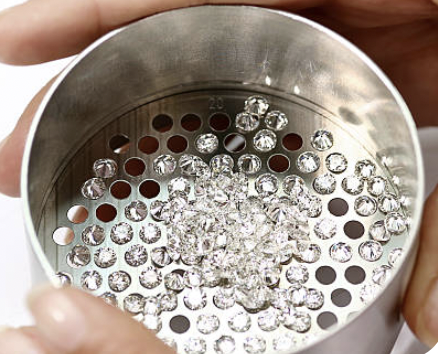
Lab-grown diamonds, also known as lab-created diamonds, grown diamonds, or cultured diamonds, have the same physical properties and chemical composition as natural diamonds. The only difference is that their origin comes from a laboratory instead of a deep mine. Lab-created diamond prices are usually much lower than natural diamond prices owing to their manufacturing process. Lab-created diamond-cutting techniques can be just as good as those used on mined stones. Their smaller size makes them more affordable for large jewellery pieces like rings but may make single-stone earrings or pendants comparatively pricey by comparison.
Diamond crystals are grown in a controlled environment from a very small diamond seed which is placed at the bottom of a vacuum chamber containing a chemical solution made up of hydrogen and methane gases. The gases are then subjected to high temperatures and pressure. The seed is coated with the solution, meaning it sucks the solution in through its seed-crystallizing over time to form a solid diamond. The diamond, which grows into a right-angle prism, is then removed from the chamber for examination and possible commercial use.
The diamond’s chemical formula (C(CO3)3), molecular crystal structure, physical properties and other characteristics are nearly the same as natural diamonds. Once the stone is cleared by the gemologists of any traces of impurities by using high-powered microscopes, it will be graded to determine its characteristics such as cut grade and clarity, color grade and value.
Man-made diamonds are prettier than other diamonds because they are free of inclusions and blemishes. Their color, clarity and shape are more perfectly matched. Technically, these stones can be graded just like mined diamonds but the lack of their natural origin means they attract a lower price in comparison. Most man-made diamond companies use the terms “lab-grown”, “cultured” or “simulated” to differentiate them from natural diamonds.
Natural diamond vs lab diamond
Blue Tint (Nuance)
When compared to an identical natural diamond, a lab-grown diamond has a slightly blue tint. Due to their manufacturing process and the clarity of their diamonds, most lab-grown diamonds are very slightly blue. However, lab-grown diamonds come in all colors including yellow, orange and purple at varying percentages of either white or colorless. Colorless lab-grown diamonds can be visually indistinguishable from natural diamonds with a strong diamond testing laboratory such as Gemesis GIA (Gemological Institute of America).
Phosphorescence
Natural diamond is transparent to white light and fluoresces a pale blue-white under UV light. However, lab-grown diamonds generally do not fluoresce but phosphoresce (glow) slightly. Some lab-grown diamonds do not phosphoresce at all while others glow very faintly in fluorescent yellow or green under UV light. This is the result of gases used during the growth process and what you are seeing are only gases that exist during the growth process, like hydrogen and methane.
Inclusions
The most common inclusion found in mined diamonds is graphite. However, lab-grown diamonds are 100% grown in a controlled environment and are completely free of graphite or other inclusions like naturally occurring fractures. While almost all natural diamonds contain carbon, only about 10% of them contain anything that is visible once the diamond is cut and polished.
In conclusion, the only difference between a natural diamond and a lab-grown is that lab-grown diamonds are man-made in a laboratory. You will have the same visual and physical impression when you see a lab-grown diamond as if it were mined – they are both diamonds. The only other differences you may find could be in their value – lab-grown diamonds are less expensive than natural ones.
Interesting Related Article: “What are Diamond Inclusions and Twinning?“

